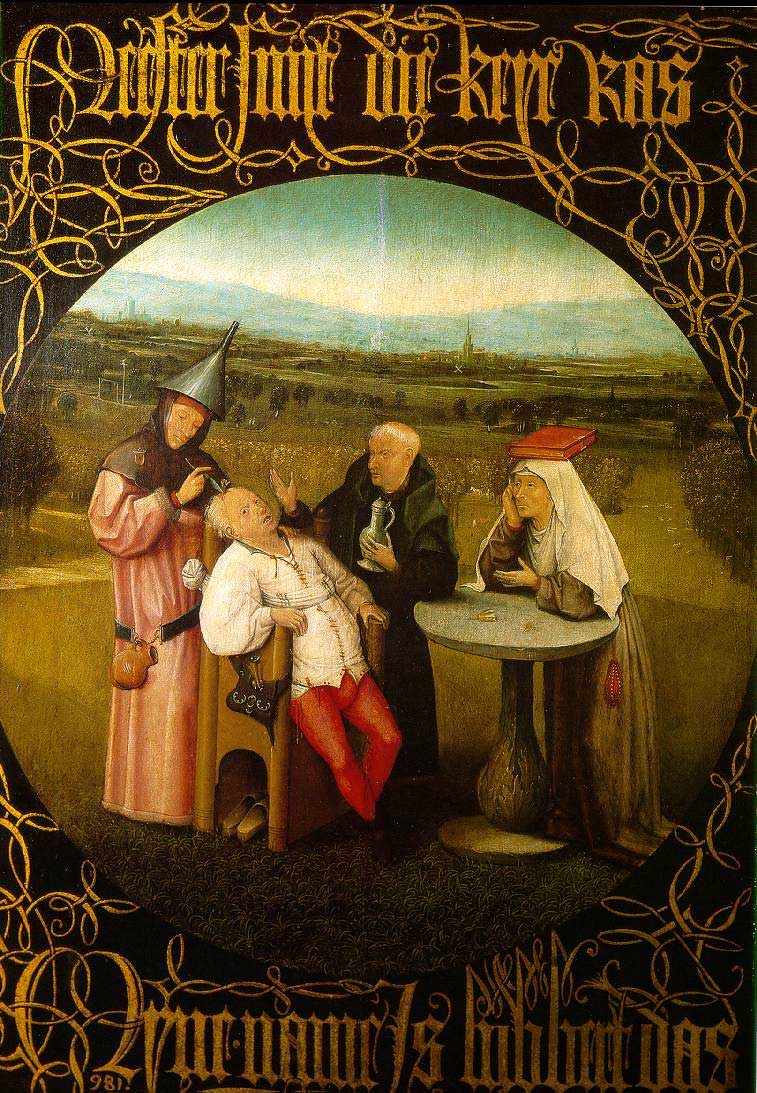Paintings

The Extraction of the Stone of Madness (The Cure of Folly), Hieronymus Bosch
1475–1480
Oil on board
48 cm × 35 cm (19 in × 14 in)
Museo del Prado, Madrid
The Extraction of the Stone of Madness (The Cure of Folly) is a painting by Hieronymus Bosch, completed between 1475 and 1480.
The painting depicts the extraction of the stone of madness, a "keye" (in English a "stone" or "bulb") from a patient's head, using trepanation by a man wearing a funnel hat.[1] In the painting Bosch has exchanged the traditional "stone" as the object of extraction with the bulb of a flower. Another flower is on the table.
The Gothic inscription reads
Meester snijt die keye ras
Mijne name Is lubbert das
(in English: "Master, cut away the stone
my name is Lubbert das").
Lubbert Das was a comical (foolish) character in Dutch literature.
Interpretations
It is possible that the flower is a pun on "tulip head" - meaning mad in Netherlands. Another possibility is that the flower hints that the doctor is a charlatan as does the funnel hat. The woman balancing a book on her head is thought by Skemmer to be a satire of the Flemish custom of wearing amulets made out of books and scripture, a pictogram for the word phylactery.[2] Otherwise, she is thought to depict folly.
Attributed works
This painting, and others by Bosch, were an inspiration to the works of the seminal Punk musicians Wire. On their album, "The Ideal Copy", they included a track titled "Madman's Honey" which included the lyric "master cut the stone out, my name is Lubbert Das" -- a direct reference to this Bosch painting.
References
1. ^ Povoledo, Elisabetta (October 27, 2008). "In Rome, a New Museum Invites a Hands-On Approach to Insanity". The Economist. http://www.nytimes.com/2008/10/28/arts/design/28insa.html?partner=rssnyt&emc=rss. Retrieved 2008-10-28. "The logo of the Mind’s Museum is an overturned funnel. It is a reference to a 15th-century painting by Hieronymus Bosch that depicts a doctor using a scalpel to extract an object (the supposed “stone of madness”) from the skull of a patient. The doctor is wearing a funnel as a hat."
2. ^ Skemer 2006:24.
Further reading
* (book on head) Binding Words Textual Amulets in the Middle Ages. Skemer, Don C. PA: Penn State Press, 2006. p. 24, 136n. ISBN 0271027223.
From Wikipedia. Text is available under the Creative Commons Attribution-ShareAlike License
